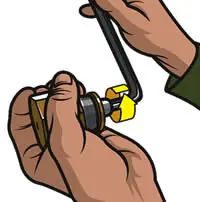Installation is the same for Shimano Hollowtech II, FSA MegaExo, and RaceFace X-Type bottom brackets. You place the bearing on an insert that fits snugly in the bearing's ID (one side has a 24mm and the other, 25mm) and place it inside the bore of the tool's cup holder, facing upward.
You place the bearing cup over it, put a support ring atop it, run the bolt through, and tighten the bolt with an 8mm hex key until it hits a dead stop (Figure 5).

Figure 5
For bottom bracket cartridges, the
same specialty tool is employed to
install as remove. Put the bearing on an
insert inside the tool. Put the bearing
cup on top of that, put the support
ring over the bearing, then tighten
with an 8mm hex until it hits a dead stop.
If the bearing is not in as far as the old one was, you will need to flip the bearing cup over, with the insert still inside of the bearing bore, and put it back into the tool's cup holder with the cup's threaded section down inside.
Re-install the bolt, and tighten it until it stops. The second pressing step is always necessary with TruVativ and SRAM GXP cranks (24mm ID bearings), because the replacement bearing (a standard size) is 1mm narrower than the (proprietary) bearing employed by TruVativ.
The non-drive side of TruVativ and SRAM GXP cranks requires yet an additional step beforehand with a special GXP insert in the tool to install the shim that stops the non-drive shoulder of the GXP spindle and establishes the side-to-side position of the crankset.
Pressing Campagnolo Ultra-Torque bearings onto each spindle stub requires the proper tool or a thick, lat-ended tube with an ID that is just bigger than the spindle's OD, which you smack with a hammer to drive the bearing into place. Replace the snapring. Enduro offers a similar tool to its external-bearing press/puller tool for BB30 bottom brackets to make installing these big bearings easy.
Pedals and Jockey Wheels
Press or tap in the new bearing with a vise, arbor press, drill press or soft hammer, using the old bearing or a socket whose OD is just under the bearing's OD. Make sure you keep the new bearing lined up from the get-go or you will be pulling it back out, because it won't straighten out without starting over if it goes in cocked.
Once you put ceramic bearings into your old parts, stop and enjoy how smoothly they spin in your hand before putting them on your bike.


